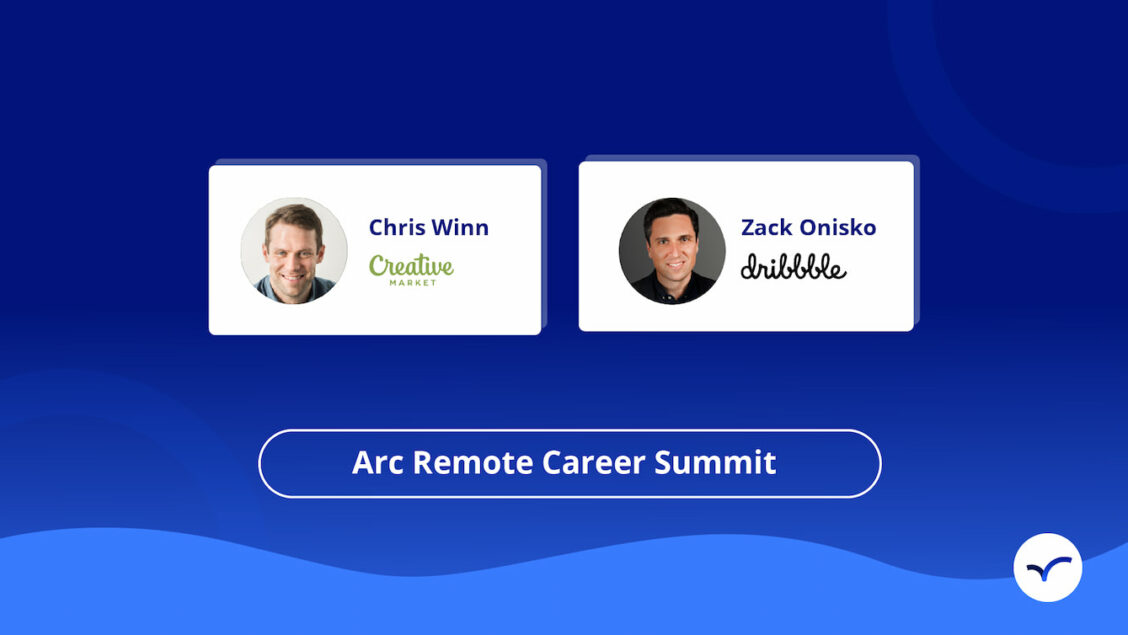How do you grow quickly, but also maintain great company culture? In this intimate conversation between Creative Market CEO Chris Winn (host) and Dribbble CEO Zack Onisko, these remote company leaders unpacked the management side of remote.
How each company operates:
- Dribbble has been fully-remote from day one.
- Creative Market has moved from a hybrid model to fully-remote. In Chris’ words, this is because they wanted to “pick a lane and be really great at one thing” (they had noticed that the company was slowly developing two distinct cultures: an in-office one, and a remote one).
Check out the talk below, or read on for a brief summary of their main talking points:
Looking for top talent fast? See how Arc can help you:
⚡️ Find developers, designers, marketers, and more
⚡️ Freelance or full-time remote + fully vetted
⚡️ Save up to 80% with global hires
Hire top talent with Arc risk-free →
Overcommunicate, Then Switch Off
Communication in global remote companies is a double-edged sword. On the one hand, you need to purposefully push clear messages between members of the team. On the other… you need to know how and when to switch off.
As Zack from Dribbble pointed out, purposeful overcommunication means that people located outside of a company’s headquarters (in a hybrid team model) means that they don’t miss the decisions being made.
At Dribbble, although they were fully-remote from the start, they were still very purposeful about maintaining overcommunication as they grew. For them, communication happens at all levels: from a weekly company all-hands to a weekly 1:1 between each team member and their manager.
Both Zack and Chris confess to being not-so-good at switching off at the end of the day. With remote work, there’s no commute home to serve as a break between work and personal time, so there are fewer cues to stop working.
Zack often finds himself checking his phone in the evening, but it’s something he’s working on stopping. However, for the company, there is an expectation that team members will work a 40 hour week — no more or less — but with some time flexibility.
Remote Teams Need to Connect Purposefully
Humor and Fun Means Connection
Dribbble’s goal is to make sure their team stays connected in personal ways, not just through work. According to Zack, they try to replicate the types of connection that naturally “you would get with somebody, you know, walking to lunch and, you know, if you work together in an office.”
In practice, their Head of Operations helps organize a lot of activities for the company, including virtual coffee hours, happy hours, games, book and movie clubs, interest-based Slack channels, etc. The company culture prioritizes fun, and they’ve found that this helps remove the professional façades that people sometimes use. Instead, team members are able to connect based on their authentic personalities.
Another remote connection activity they tried recently was linked to exercise: a “remote 5k” in which the team all encouraged each other to do exercise and gift virtual reward coins (which could then be cashed out or gifted to charity.)
In-Person Time is Still Important
Something many fully-remote companies have in common is an annual retreat. Dribbble generally has the whole team meet up in person twice per year. The purpose of this isn’t to work; rather, it’s to have fun! The retreat starts with a single day of work, with the remainder of the time dedicated to fun activities and team bonding.
Chris also spoke about the benefits that can come from spending time in person, offering a story from the Creative Market team. One of the Creative Market marketing team members had met one of their infrastructure engineers during a team trip. ]Although the paths of these two team members would rarely cross in the normal course of business, this chance meeting led them to have a different relationship on Slack post-trip, including reaching out to each other for insights on projects.
Deep Work By Design (and Trust)
According to Zack, the main benefit of remote is that “it allows people to build their perfect day.” Whether that’s spending time with family, or going running/biking, both Chris and Zack agreed that time flexibility has had benefits for them. That said, time management is important!
Dribbble has certain calendar settings that apply to the whole organization. Thursdays and Fridays are no-meeting days, and the team is able to do deep work without interruption. That said, for roles like Zack’s, it’s not necessarily possible to avoid all meetings on those days — instead, he may be having calls with people from outside the team.
When it comes to the remaining aspects of schedule management, Zack is fairly hands-off. One of the big lessons of remote team management is realizing that lack of trust is a blocker for managers. Instead, trust your team to get their work done on the schedule that suits them best.
You can also try Arc, your shortcut to the world’s best remote talent:
⚡️ Access 450,000 top developers, designers, and marketers
⚡️ Vetted and ready to interview
⚡️ Freelance or full-time
Try Arc and hire top talent now →
5 Tips for Scaling a Remote Team
1. Start With Strong Foundations
Dribbble’s team has grown in size in recent years — from being a side project of its founders to a full-blown company in its own right. Zack was brought in as CEO during this growth period and has led this change.
One of the things that made Dribbble’s scaling experience work more smoothly was having best practices in place as a foundation when they were still small. This means getting the basics right, e.g. a rigorous onboarding process, including:
- The new employee meets everybody else for a one-on-one video session
- Giving the new employee a buddy within the organization
- Providing a glossary of Dribbble’s internal “language” and documentation around Slack use expectations (e.g., notifications, muting rules, hours, etc.).
However, Zack also mentioned that there’s a flip side to this: Dribbble also avoids too much process. In his words, they want “just enough to keep all the pieces together and make everything coherent.”
Have a North Star and Organizational Values
One of the things that Zack implemented as CEO was having a North Star for where they wanted to go as a company, and who they were serving. Basically, this means determining their mission and vision statement (their mission is to help designers become successful!). They also clarified and wrote down their values as an organization.
The outcome of these actions, according to Zack, included causing Dribbble to evolve who they were as a company, including “how we acted and who we hired.”
Embrace Change and Different Views
One thing that Zack wanted to ensure was that Dribbble, as a company “weren’t afraid to evolve and grow.” Chris, likewise, encourages change and growth at Creative Market, going so far as to encourage contrarian voices.
As he says: “what got you there is not always what’s going to get you to the next step.” Both CEOs agree that there’s value in taking intelligent risks!
Learn to Delegate
In a small team, everybody works together. But as an organization grows, delegation becomes more important. Zack realized that he had become “a blocker for everything. Like, everyone had to ask me permission to do things.” He also realized this was holding his team back, and had to learn to let go.
Hire “Doers”
Zack shared insights from his experiences at hiring for Dribbble, including mistakes he has made. One thing he values in a team member is the ability to “exercise those muscles of their function.” What he means by this is when hiring for leadership, ensure that the candidate still knows how to actually produce work — be wary of hiring only for delegation and management skills.
Additionally, finding people who really love — and are productive at — working remotely is critical. As part of this, Chris says, you need to “be real about what remote is and what it isn’t.” He advises having these conversations up-front, and being open about it.
Thanks to Chris and Zack for their CEO-level insights into managing remote companies! Do you have any tips or experiences to add? Let us know in the comments!
You can also try Arc, your shortcut to the world’s best remote talent:
⚡️ Access 450,000 top developers, designers, and marketers
⚡️ Vetted and ready to interview
⚡️ Freelance or full-time








